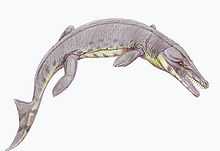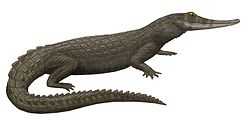Hulkepholis
| Hulkepholis Temporal range: Early Cretaceous, 135–112Ma | |
|---|---|
| Scientific classification | |
| Kingdom: | Animalia |
| Phylum: | Chordata |
| Class: | Reptilia |
| Superorder: | Crocodylomorpha |
| Family: | †Goniopholididae |
| Genus: | †Hulkepholis Buscalioni et al., 2013 |
| Type species | |
| †Goniopholis willetti Salisbury & Naish, 2011 | |
| Species | |
| |
Hulkepholis is an extinct genus of goniopholidid mesoeucrocodylian from the Early Cretaceous of southern England and eastern Spain. It contains two species, the type species, Hulkepholis willetti, and also H. plotos. Hulkepholis is most closely related to both species of Anteophthalmosuchus and to the unnamed "Dollo’s goniopholidid".[1][2][3]
Discovery
H. willetti is known from a single holotype specimen, BMNHB 001876 from the Wealden Group of the Isle of Wight that includes a well-preserved nearly complete skull.[3] It was collected by Edgar W. Willett at Cuckfield, West Sussex, from the Valanginian-aged Grinstead Clay Formation, of the Hastings Group, Wealden Supergroup. Willett showed the specimen to the Geological Society of London in or around 1877 or 1878, and it was then Hulke (1878) described it as a specimen of Goniopholis crassidens, an identification derived from a similar tooth form. The specimen was considered lost among the crocodyliform research community but was actually safely accessioned at the Booth Museum in Brighton. It was identified as "the long-lost crocodilian of Mr Willett" by Steve (1998), "Willett’s specimen" by Salisbury et al. (1999) and "Hulke’s specimen" by Andrande et al. (2011).[4] It was assigned to a new species of Goniopholis, Goniopholis willetti, by Salisbury and Naish in 2011 honoring its collector.[1] A broad phylogenetic analysis of crocodyliforms published the same year by Andrande et al. (2011), found the specimen to be the sister taxon of the clade formed by Anteophthalmosuchus hooleyi and the unnamed "Dollo’s goniopholidid".[5] Thus it was reassigned to its own genus by Buscalioni et al. (2013), creating the combinatio nova, Hulkepholis willetti. The generic name honors John Whitaker Hulke who described the specimen as belonging to Goniopholis.[3]
A second species, Hulkepholis plotos, was first described and named by A.D. Buscalioni, L. Alcalá, E. Espílez and L. Mampel in 2013. The specific name is derived from Greek mythology πλοτός, plotos, the drifter. It is known solely from the holotype AR-1/56, a partial skeleton which consists of AR-1-2045, a nearly complete but crushed skull; AR-1-2048, 4859, 4860, three vertebrae; AR-1-2046, a rib; AR-1-2048, a metapodial; and AR-1-2049, 4861, 4862, three osteoderms. It was collected from the early Albian-aged Escucha Formation, at Santa Maria Mine located in the municipality of Ariño, Teruel Province, of Aragon, along with the closely related Anteophthalmosuchus escuchae.[3]
Phylogeny
Goniopholis willetti was included in a phylogenetic analysis of goniopholidids that was published soon before the specimen was redescribed. It was found to be most closely related to the clade formed by a specimen called "Dollo's goniopholidid", and "Hooley’s goniopholidid", now named Anteophthalmosuchus hooleyi. Below is a cladogram from that analysis:[5]
| Neosuchia |
| ||||||||||||||||||||||||||||||||||||||||||||||||||||||||||||||||||||||||||||||||||||||||||||||||||||||||||||||||||||||||||||||||||||
| |
References
- ↑ 1.0 1.1 Steven W. Salisbury and Darren Naish (2011). "Crocodilians". In Batten, D. J. (eds). English Wealden Fossils. The Palaeontological Association (London). pp. 305–369.
- ↑ Naish, Darren (2 December 2011). "The Wealden Bible: English Wealden Fossils, 2011". Tetrapod Zoology. Scientific American Blogs. Retrieved 5 December 2011.
- ↑ 3.0 3.1 3.2 3.3 Buscalioni, A.D.; Alcalá, L.; Espílez, E. & Mampel, L. (2013). "European Goniopholididae from the Early Albian Escucha Formation in Ariño (Teruel, Aragón, España)". Spanish Journal of Paleontology 28 (1): 103–122.
- ↑ Naish, Darren (24 September 2012). "In pursuit of Early Cretaceous crocodyliforms in southern England: ode to Goniopholididae". Tetrapod Zoology. Scientific American Blogs. Retrieved 24 September 2012.
- ↑ 5.0 5.1 De Andrade, M. B.; Edmonds, R.; Benton, M. J.; Schouten, R. (2011). "A new Berriasian species of Goniopholis (Mesoeucrocodylia, Neosuchia) from England, and a review of the genus". Zoological Journal of the Linnean Society 163: S66. doi:10.1111/j.1096-3642.2011.00709.x.
| ||||||||||||||||||||||||||||||||||||||||||||||||||||||||||||||||||||||||||||||||||||||||||||||||||||||||||

